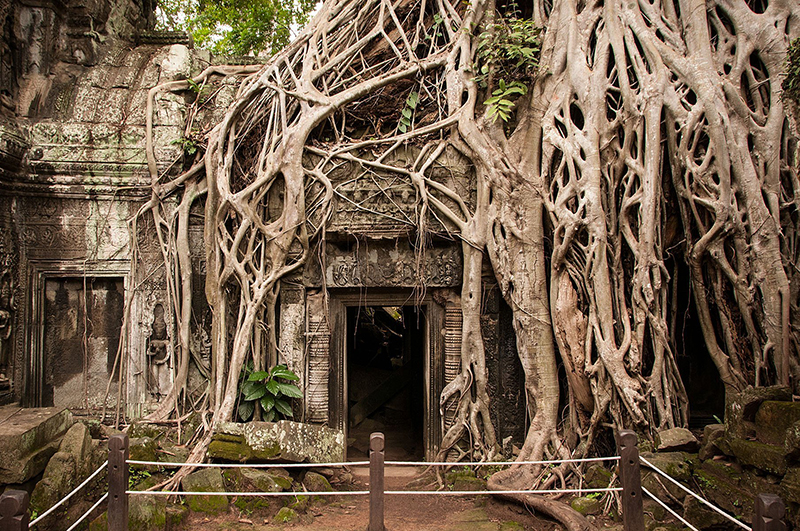Ta Prohm
Constructed : Mid-12th century to early 13th century (1186)
Location : In south-east of Ta Keo and east of Angkor Thom
Access : Walking from east or west entrances (north gate is highly recommended)
Religion : Buddhism (dedicated to the mother of the king)
King : Jayavarman VII (reigned 1181-1220)
Art Style : Bayon
Ta Prohm was left untouched by archaeologists, except for the clearing of a path for visitors and structural strengthening to stave off further deterioration. Because of its natural state, it is possible to experience at this temple some of the wonder of the early explorers, when they came upon these monuments in the middle of 19th century. Shrouded in jungle, the temple of Ta Prohm is ethereal in aspect and conjures up a romantic aura. Trunks of trees twist amongst stone pillars. Fig, banyan and kapok trees spread their gigantic roots over, under and in between the stones, probing walls and terraces apart, as their branches and leaves intertwine to form a roof above the structures.
'Everywhere around you, you see nature in its dual role of destroyers and consoler, strangling on the one hand, and healing on the other, no sooner splitting the carved stones asunder than she dresses their wounds with cool, velvety mosses and binds them with her most delicate tendrils, a conflict of moods so contraditory and femenine as to prove once more - if proof were needed - how well 'Dame' nature merits her femenine title.
The monastic complex of Ta Prohm is one of the largest sites at Angkor. A Sanskrit inscription on stone, now removed to the Conservation D'Angkor, tells us something about its size and function. Ta Prohm owned 3,140 villages. It took 79,365 people to maintain the temple, including 18 high priests, 2,740 officials, 2,202 assistants and 615 dancers. Among the property belonging to temple was a set of golden dishes weighing more than 500 kilograms (1,100 pounds) 35 diamonds, 40,620 pearls, 4,540 precious stones, 876 veils from China, 512 silk beds and 523 parasols. Even considering that these numbers were probably exaggerated to glorify the king, Ta Prohm must have been an important and impressive monument.


